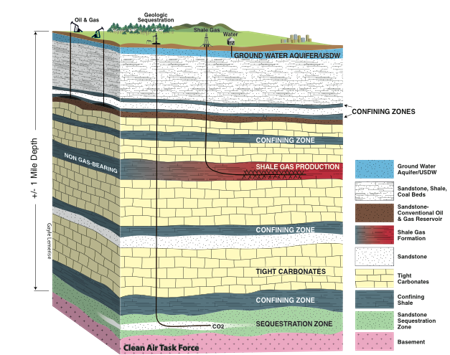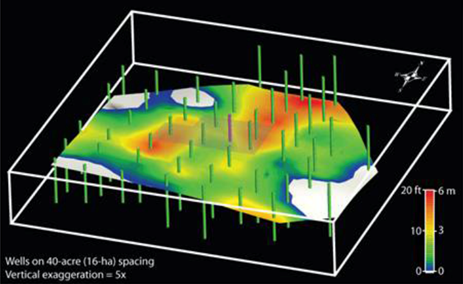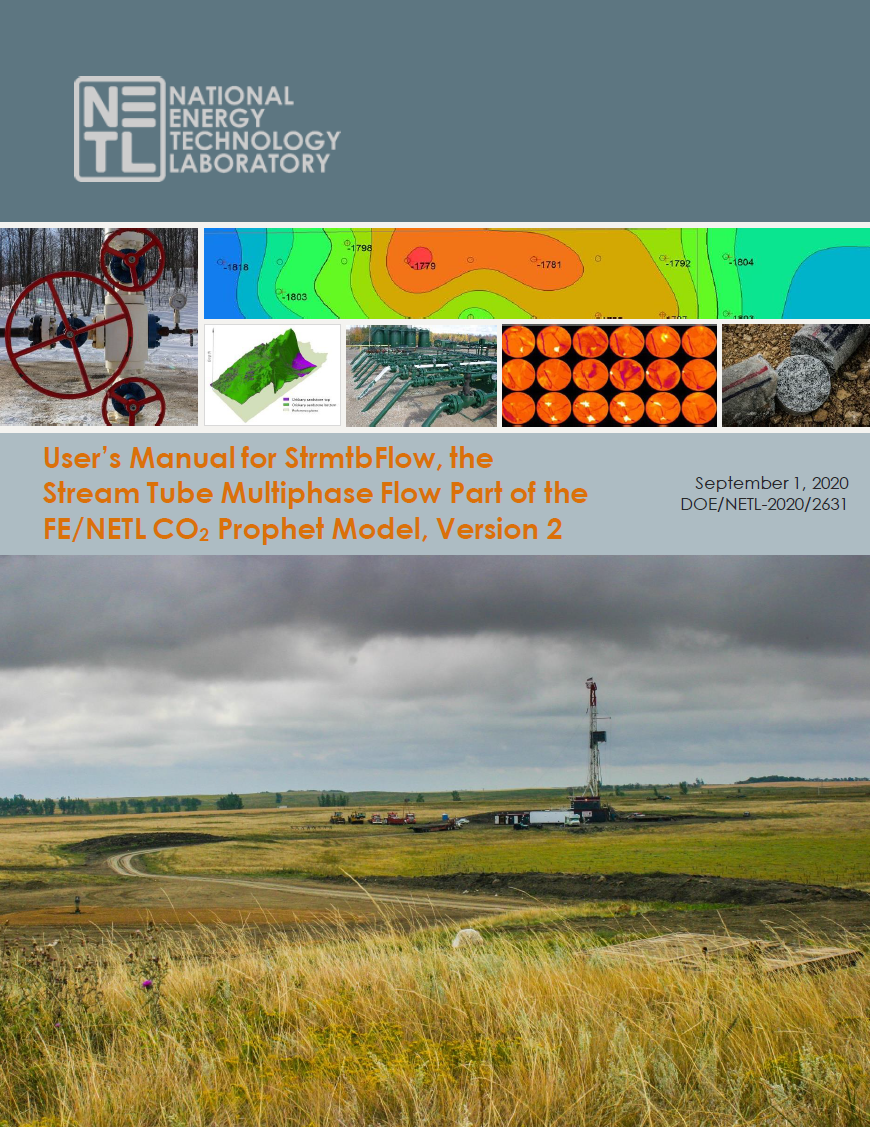Carbon Storage Analysis
Overview
The objective of the Carbon Storage Program (CSP) is to create a portfolio of carbon management options to manage emission levels and develop and advance carbon capture, utilization, and storage (CCUS) technologies for widespread commercial deployment by the 2025-2035 timeframe. In order to meet this objective, the Carbon Storage Analysis Field Work Proposal (FWP) portfolio of projects works towards developing, updating, and utilizing new modeling toolsets and technologies to identify the most cost-effective CCUS deployment strategies. This project portfolio leverages advance modeling approaches coupled with critical data analysis representative of real carbon storage scenarios and deployment of CCUS technologies.
Approach
The technical task of the Carbon Storage Analysis FWP is to better understand the engineering requirements of the subsurface for integrated commercial-scale CCUS in diverse geological formations. The FWP’s fundamental task is to analyze the business scenarios and impact of financial/policy incentives on the development of initial CCUS projects. This analytical work improves understanding of the technical and economic challenges and risks associated with locating, developing, operating, and closing out a CO2 storage project, both onshore and offshore; develops, applies, and/or maintains appropriate models to provide economic, life cycle, or risk analysis of CCUS value chain scenarios; and conducts modeling at a reservoir and basin scale to better understand geologic parameters that influence the cost of CCUS.
Current analysis of CO2 storage has been focused on single projects in some basins. The Carbon Storage Analysis work models CO2 storage projects at the regional level to better illustrate deployment challenges in other regions of the country not previously analyzed. Modeling storage at the basin level provides a perspective on the potential need for basin management regarding the sequential development of multiple storage projects, both vertical and laterally within a basin. Modeling Enhanced Oil Recovery (EOR) operations improves the understanding of associated storage of CO2 as well as EOR’s ability to fit within the CCUS network—by attracting investment and facilitating deployment of CCUS technology.
Anticipated Outcomes
Researchers provide analysis of costs, in part for the whole value chain, associated with the capture, transport, utilization, and storage of CO2 through advanced economic modeling and life cycle analyses. Outcomes include:
- Analysis of onshore CO2 storage, including operations, water production, surface and subsurface risks, transportation, and the value-added opportunities of EOR and storage.
- Analysis of offshore CO2 storage opportunities, either saline or associated storage with EOR valued-added opportunities.
- Analysis to provide a better understanding of the economic, policy, and financial drivers of large-scale onshore and offshore carbon storage operations and/or utilization in CO2 -EOR.
- Modeling, assessment, and communication of the environmental trade-offs to accelerating national and international acceptance of carbon storage management strategies.
- Update storage efficiency factors for CO2 storage based on new data targeted for specific storage reservoirs in saline formations.
Themes
General CCUS Analysis / Life-Cycle Analysis – Integral to the research and development (R&D) of the Carbon Storage Analysis FWP are both general CCUS analysis and Life-Cycle Analysis (LCA). NETL is at the forefront for developing, analyzing, and testing CCUS technology at every stage of the CCUS value chain in order to ensure safe, secure, efficient, and affordable CO2 injection and containment onshore and offshore. Moreover, NETL’s LCA models access and communicate the environmental trade-offs of geological storage of CO2 in order to accelerate national and international acceptance of carbon storage strategies, enabling better energy security.
Techno-Economic Analysis – The NETL research team supporting the Carbon Storage Analysis FWP utilizes techno-economic analysis to provide economic, financial, and policy analysis of large-scale CO2 capture and storage projects. A more comprehensive perspective of the economic challenges surrounding CCUS technologies will aid stakeholders and industry partners in developing successful future CCUS projects.
Modeling Onshore and Offshore CO₂ Storage and Transportation – The NETL research team supporting the Carbon Storage Analysis FWP utilizes various data sources and cost models in order to dynamically illustrate and provide quantitative estimates of the impact of DOE/NETL R&D on the economics of CO2 storage for the development of fundamental CCUS studies leading to onshore and offshore deployment of CCUS technology.
Subsurface Structure
Life Cycle Analysis (LCA) is a comprehensive form of analysis that utilizes the principles of Life Cycle Assessment, Life Cycle Cost Analysis, and various other methods to evaluate the environmental, economic, and social attributes of energy systems.
Cross-section illustrating how carbon dioxide can be used to improve production of oil after primary and secondary recovery.
3D illustration of injection and production wells and CO2 saturation within a reservoir.
StrmtbFlow and StrmtbGen comprise the FE/NETL CO2 Prophet Model, which is a streamline/stream tube reservoir simulator for modeling CO2 EOR.
Recent Research Products
45Q tax credit impacts on carbon management costs: Case study findings and modeling developments
Warner, T., Harker Steele, A., Grant, T., Vikara, D., & Balash, P. (2021, November 1-2). 45Q tax credit impacts on carbon management costs: Case study findings and modeling developments [Conference presentation]. The USAEE/IAEE North American Virtual Conference, Virtual.
Comparative analysis of CO2 transport, storage, and produced water management options from a CO2 source perspective
Grant, T.C., Guinan, A., Wendt, A., Basista, E., Shih, C., Lin, S. Vokara, D., Morgan, D., & Remson, D. (2021, September 26-October 1). Comparative analysis of CO2 transport, storage, and produced water management options from a CO2 source perspective [Conference presentation]. SEG/AAPG IMAGE 2021, Virtual.
Section 45Q tax credit impacts on carbon management: Case study findings and modeling developments
Warner, T., Vikara, D., Iyengar, A., Guinan, A., Harker Steele, A., Nichols, C., Grant, T., Morgan, D., Remson, D., Cunha, L., & Balash, P. (2021, September 20-23). Section 45Q tax credit impacts on carbon management: Case study findings and modeling developments [Conference presentation]. The International Pittsburgh Coal Conference, Virtual.
Examining possible CCS deployment pathways: Onshore and offshore
Grant, T. (2021, August 4-11). Examining possible CCS deployment pathways: Onshore and offshore (FWP-1022464) [Conference presentation]. 2021 DOE-NETL Carbon Management and Oil and Gas Project Review Meeting – Carbon Storage, Virtual. https://netl.doe.gov/sites/default/files/netl-file/21CMOG_CS_Grant6.pdf
Comparative analysis of carbon capture and storage finance gaps and the social cost of carbon
Harker Steele, A., Warner, T., Vikara, D., Guinan, A., & Balash, P. (2021). Comparative analysis of carbon capture and storage finance gaps and the social cost of carbon. Energies, 14(11) 2987. https://doi.org/10.3390/en14112987









